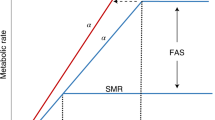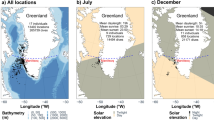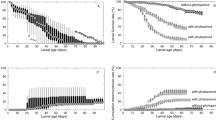Abstract
Many aquatic animals make daily vertical migrations, typically ascending into warm shallow strata for the night and descending to cooler, deeper layers of lakes or oceans for the day. Although some organisms may migrate to avoid predation1–3 researchers have also suggested that daily migration is a thermoregulatory strategy allowing ectotherms to lower their metabolic rates in cold, deep waters, thus conserving energy4,5. Tests of this hypothesis, however, have been equivocal6–8. Here we suggest an alternative hypothesis: that fish ascend into warmer water after feeding to stimulate digestion, thereby allowing greater feeding and growth. We tested this hypothesis using the Bear Lake sculpin (Cottus extensus) which feeds on the bed of the lake during the day, and at night migrates into the water column where temperatures are 10 °C warmer. The warmer temperatures promoted digestion and allowed the fish to feed and grow three times faster than if they had remained in the cold hypolimnion. Thus, daily vertical migration in this species is an adaptation allowing them to exploit thermal gradients in their environment9 to maximize energetic intake.
This is a preview of subscription content, access via your institution
Access options
Subscribe to this journal
Receive 51 print issues and online access
$199.00 per year
only $3.90 per issue
Buy this article
- Purchase on Springer Link
- Instant access to full article PDF
Prices may be subject to local taxes which are calculated during checkout
Similar content being viewed by others
References
Gliwicz, J. Z. Nature 320, 746–748 (1986).
Stich, H. B. & Lampert, W. Nature 293, 396–398 (1981).
Clark, C. W. & Levy, D. A. Am. Nat. 131, 271–290 (1988).
McLaren, I. A. J. Fish. Res. Bd Can. 20, 685–727 (1963).
Brett, J. R. Am. Zool. 11, 99–113 (1971).
Lock, A. R. & McLaren, I. A. Limnol. Oceanogr. 15, 638–640 (1970).
Swift, M. C. Ecology 57, 900–914 (1976).
Biette, R. M. & Geen, G. H. Can. J. Fish. Aquatic Sci. 37, 203–210 (1980).
Crowder, L. B. & Magnusson, J. J. in Behavioral Energetics: The Cost of Survival in Vertebrates (eds Aspey, W. P. & Lustick, S. I.) 189–221 (Ohio State Univ. Press, Columbus, 1983).
Persson, L. in Contemporary Studies on Fish Feeding (eds Simenstad, C. A. & Cailliet, G. M.) 51–58 (Junk, Dordrecht, 1986).
White, J. R. & Li, H. W. Comp. Biochem. Physiol. 81A, 25–33 (1985).
Huey, R. B. in Biology of the Reptilia Vol. 12 (eds Gans, C. & Pough, F. H.) 25–91 (Academic, New York, 1982).
Reynolds, W. W. & Casterlin, M. E. Am. Zool. 19, 211–224 (1979).
Avery, R. A. Symp. zool. Soc. Lond. 52, 407–424 (1984).
Christian, K. A. Can J. Zool. 64, 836–840 (1986).
Lillywhite, H. B., Licht, P. & Chelgren, P. Ecology 54, 375–383 (1973).
Wurtsbaugh, W. A. & Cech, J. J. Trans. Am. Fish. Soc. 12, 653–660 (1983).
Author information
Authors and Affiliations
Rights and permissions
About this article
Cite this article
Wurtsbaugh, W., Neverman, D. Post-feeding thermotaxis and daily vertical migration in a larval fish. Nature 333, 846–848 (1988). https://doi.org/10.1038/333846a0
Received:
Accepted:
Issue Date:
DOI: https://doi.org/10.1038/333846a0
This article is cited by
-
Evidence for the importance of invasive Dreissena veligers as a novel prey item for larval fish in Lake Huron
Hydrobiologia (2023)
-
The importance of warm habitat to the growth regime of cold-water fishes
Nature Climate Change (2021)
-
Target Strength and swimbladder morphology of Mueller’s pearlside (Maurolicus muelleri)
Scientific Reports (2019)
-
Spatiotemporal drivers of energy expenditure in a coastal marine fish
Oecologia (2017)
-
Going with the Flow: Spatial Distributions of Juvenile Coho Salmon Track an Annually Shifting Mosaic of Water Temperature
Ecosystems (2013)
Comments
By submitting a comment you agree to abide by our Terms and Community Guidelines. If you find something abusive or that does not comply with our terms or guidelines please flag it as inappropriate.



